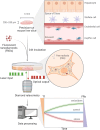Free radical detection in precision-cut mouse liver slices with diamond-based quantum sensing
- PMID: 39401360
- PMCID: PMC11513939
- DOI: 10.1073/pnas.2317921121
Free radical detection in precision-cut mouse liver slices with diamond-based quantum sensing
Abstract
Free radical generation plays a key role in many biological processes including cell communication, maturation, and aging. In addition, free radical generation is usually elevated in cells under stress as is the case for many different pathological conditions. In liver tissue, cells produce radicals when exposed to toxic substances but also, for instance, in cancer, alcoholic liver disease and liver cirrhosis. However, free radicals are small, short-lived, and occur in low abundance making them challenging to detect and especially to time resolve, leading to a lack of nanoscale information. Recently, our group has demonstrated that diamond-based quantum sensing offers a solution to measure free radical generation in single living cells. The method is based on defects in diamonds, the so-called nitrogen-vacancy centers, which change their optical properties based on their magnetic surrounding. As a result, this technique reveals magnetic resonance signals by optical means offering high sensitivity. However, compared to cells, there are several challenges that we resolved here: Tissues are more fragile, have a higher background fluorescence, have less particle uptake, and do not adhere to microscopy slides. Here, we overcame those challenges and adapted the method to perform measurements in living tissues. More specifically, we used precision-cut liver slices and were able to detect free radical generation during a stress response to ethanol, as well as the reduction in the radical load after adding an antioxidant.
Keywords: NV center; diamonds; nanodiamonds; quantum sensing.
Conflict of interest statement
Competing interests statement:R.S. is founder of the spin off company QTsense. A patent has been filed about diamond-based quantum sensing in tissues. The other authors have no conflict of interest to declare.
Figures








Similar articles
-
Quantum sensing to monitor changes in free radical generation by intracellular vesicles of polarized macrophages.Acta Biomater. 2025 Jun 1;199:315-323. doi: 10.1016/j.actbio.2025.04.024. Epub 2025 Apr 11. Acta Biomater. 2025. PMID: 40222601
-
Diamond-Based Nanoscale Quantum Relaxometry for Sensing Free Radical Production in Cells.Small. 2022 Nov;18(44):e2105750. doi: 10.1002/smll.202105750. Epub 2022 Sep 28. Small. 2022. PMID: 36169083
-
Nanodiamond Relaxometry-Based Detection of Free-Radical Species When Produced in Chemical Reactions in Biologically Relevant Conditions.ACS Sens. 2020 Dec 24;5(12):3862-3869. doi: 10.1021/acssensors.0c01037. Epub 2020 Dec 3. ACS Sens. 2020. PMID: 33269596 Free PMC article.
-
Emerging Diamond Quantum Sensing in Bio-Membranes.Membranes (Basel). 2022 Sep 30;12(10):957. doi: 10.3390/membranes12100957. Membranes (Basel). 2022. PMID: 36295716 Free PMC article. Review.
-
Toward Quantitative Bio-sensing with Nitrogen-Vacancy Center in Diamond.ACS Sens. 2021 Jun 25;6(6):2077-2107. doi: 10.1021/acssensors.1c00415. Epub 2021 May 26. ACS Sens. 2021. PMID: 34038091 Review.
References
-
- Rondin L., et al. , Magnetometry with nitrogen-vacancy defects in diamond. Rep. Prog. Phys. 77, 056503 (2014). - PubMed
-
- Mamin H. J., et al. , Nanoscale nuclear magnetic resonance with a nitrogen-vacancy spin sensor. Science 339, 557–560 (2013). - PubMed
-
- Grinolds M. S., et al. , Nanoscale magnetic imaging of a single electron spin under ambient conditions. Nat. Phys. 9, 215–219 (2013).
-
- Hong S., et al. , Nanoscale magnetometry with NV centers in diamond. MRS Bull. 38, 155–161 (2013).
-
- McCoey J. M., et al. , Rapid, high-resolution magnetic microscopy of single magnetic microbeads. Small 15, 1805159 (2019). - PubMed
MeSH terms
Substances
Grants and funding
LinkOut - more resources
Full Text Sources
Research Materials

